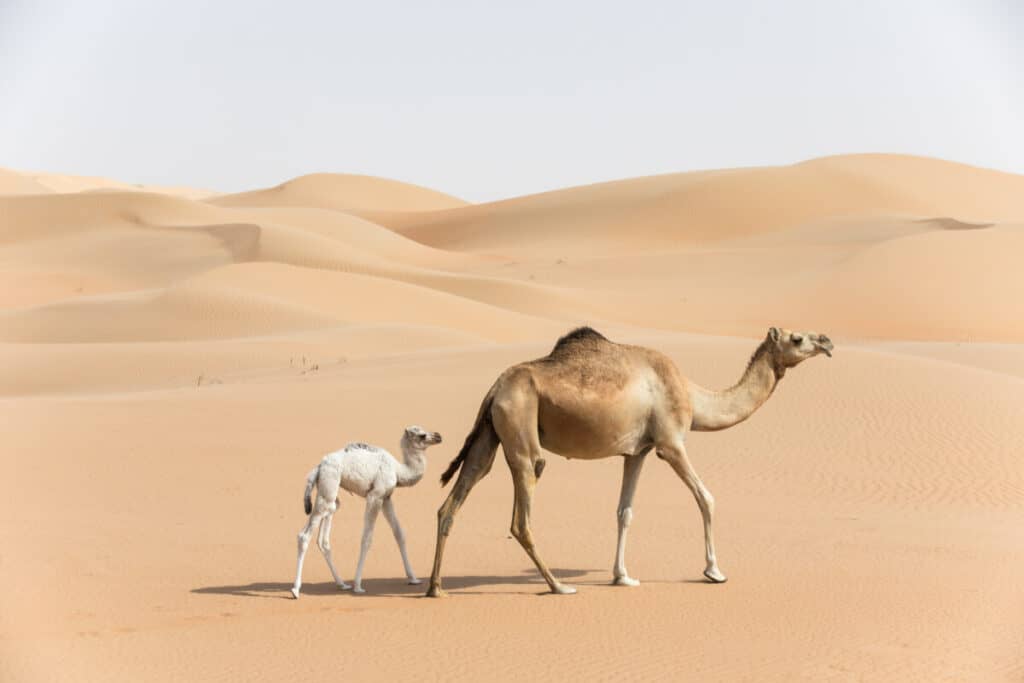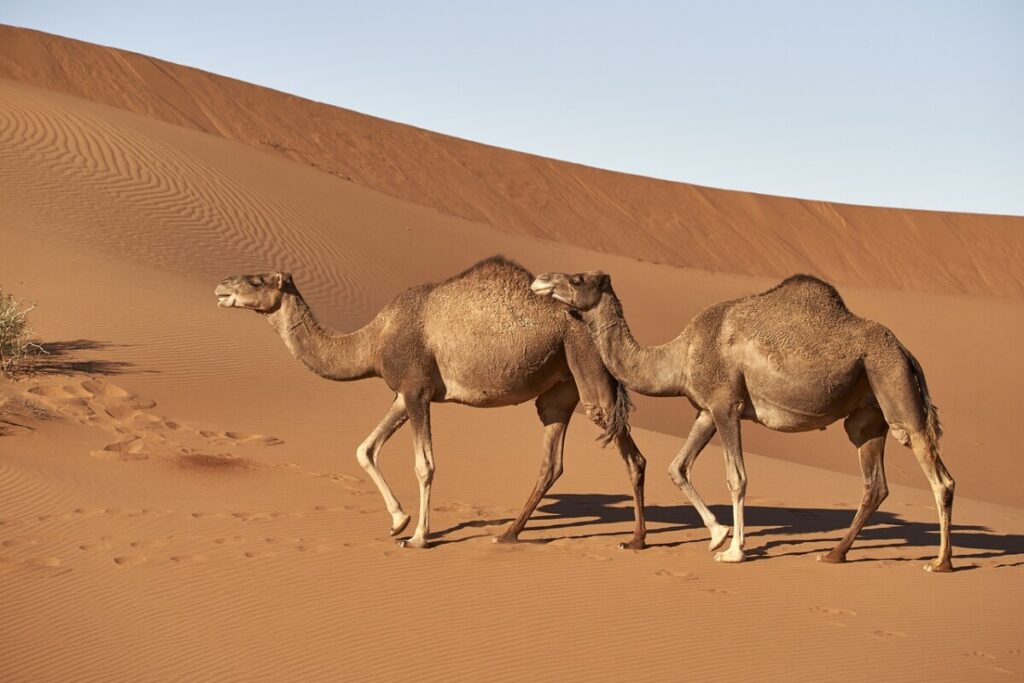The dromedary camel, also known as the Arabian camel, is a domesticated animal that has been used by humans for transportation and as a source of food and milk for thousands of years. These animals are well-known for their ability to survive in harsh desert environments where water and food can be scarce. One of the key factors that enable camels to thrive in such conditions is their exceptional senses.
Dromedary camels have highly developed senses of smell, hearing, and sight. Camels rely on their senses to find food, water, and avoid predators in the harsh desert environment. Camels use multiple senses at once to make decisions about navigating through the desert. Camels’ sensory adaptations are remarkable and unique, providing insights into how they have adapted to life in the desert.
In this article, we will explore how good the senses of dromedary camels really are. Specifically, we will discuss their sense of smell, hearing, and sight. By examining these senses in detail, we hope to gain a better understanding of how these animals have adapted to life in the desert and how they use their senses to find food, water, and avoid predators.

The Exceptional Sense of Smell of Dromedary Camels
The olfactory system of dromedary camels is remarkably sensitive, allowing them to detect food, water, and predators from great distances. Studies have shown that they possess a highly developed sense of smell which can be attributed to their large nasal cavity and the presence of specialized receptors in their nostrils. This enables them to identify different smells and distinguish between subtle variations with remarkable accuracy.
Dromedary camel olfactory abilities have significant implications for hunting and tracking. They are used extensively by Bedouin tribes for searching for food sources such as wild herbs and shrubs. Additionally, they are also employed in finding underground water sources by following the scent trail left behind by damp soil or vegetation. Their ability to detect predators from miles away helps them avoid potential danger while grazing in open spaces. The exceptional sense of smell possessed by dromedary camels has played an important role in their survival in harsh desert environments where resources are scarce, making them an invaluable asset for humans who rely on these animals for transportation and sustenance.
How Camels Use Their Sense of Smell to Find Water
Utilizing their olfactory abilities, these desert creatures are able to detect even the slightest traces of water in the arid landscape. In fact, camels’ sense of smell extends beyond just locating water sources. They also rely on their sense of smell to detect predators and find food in the barren environment.
However, camels’ olfactory system is not limited to survival instincts alone. Their sense of smell plays a crucial role in communication and socialization within camel communities. The anatomy of camels’ olfactory system shares similarities with other mammals, such as having an olfactory epithelium that detects different odors. However, camels have larger turbinates (swirling structures inside the nasal cavity) that allow for greater surface area for detecting scents. Overall, camels’ exceptional sense of smell is instrumental in helping them navigate through their harsh desert habitat and interact with others in their species.
The Importance of Smell for Camels’ Survival in the Desert
Camels’ survival in the desert is heavily dependent on their exceptional sense of smell. In the harsh and arid environment where water sources are scarce and unpredictable, camels have evolved to become experts at detecting even the slightest scent of moisture. Their sense of smell is so acute that they can detect water from miles away, and can locate hidden underground wells by sniffing out the damp soil surrounding them.
The importance of smell for camels’ survival in the desert cannot be overstated. Without their ability to locate water sources with precision, these animals would not be able to survive in such a hostile environment. Camels have also been known to use their sense of smell to find food, as they are able to detect the scent of plants that are buried underneath sand or soil. Overall, it is clear that camels rely heavily on their sense of smell for survival in the desert, and this adaptation has allowed them to thrive in one of the harshest environments on Earth.
The Incredible Hearing Abilities of Dromedary Camels
In the arid desert landscape, the ability of dromedary camels to detect even the faintest sounds is a remarkable adaptation for survival. Their ears are not only large, but also flexible and can rotate up to 180 degrees in any direction. This allows them to locate the source of a sound quickly and accurately, be it from their prey or predator.
Dromedary camel hearing: anatomy and function
- The ear canal of a dromedary camel can be up to 7 cm long, which helps amplify sound waves.
- The auditory bulla, a bony structure that encloses the middle ear, is well-developed in camels and aids in detecting low-frequency sounds.
- Camels have high-frequency hearing abilities that allow them to detect communication signals from other camels over long distances.
Communication through vocalization
- Dromedary camels use various vocalizations such as grunts, snarls, moans and bleats for communication.
- They can produce loud roars during mating season or when threatened by predators. These roars can be heard several kilometers away.
How Camels Use Their Hearing to Detect Dangers
The acute hearing abilities of desert-dwelling mammals have enabled them to survive in challenging environments by detecting potential threats from afar. Dromedary camels are no exception and their long, curved ears are capable of picking up sounds that are not audible to the human ear. Camels use their sense of hearing to detect predators such as lions, hyenas and wolves. They can hear these animals approaching from miles away and quickly take evasive action.
In addition to detecting predators, camels also use their sense of hearing for communication with their herd members. They make a range of vocalizations including grunts, snorts and bellows which convey different messages about food availability, mating opportunities or danger alerts. Camels also have the ability to communicate silently using body language such as ear position or head movement. The table below summarizes the different types of camel vocalizations along with their meanings:
| Vocalization | Meaning |
|---|---|
| Grunt | Greeting |
| Snort | Warning |
| Bellow | Aggression |
| Groan | Discomfort or pain |
| Moan | Mating call |
Overall, the keen sense of hearing possessed by dromedary camels is crucial for their survival in harsh desert environments where dangers may lurk at any moment. Through communication with their herd members and vigilance against predators, these animals have managed to thrive in some of the harshest conditions on earth.

Sight in Dromedary Camels: Myths and Realities
Despite common misconceptions, the visual acuity of desert-dwelling mammals such as dromedary camels is not inferior to that of humans. In fact, research has shown that camels have a higher density of cones in their retinas than humans do, which allows them to see better in bright light and perceive colors more vividly. Additionally, camels have a distinctive horizontal pupil shape that provides them with a wider field of vision and improves their depth perception.
However, there are still many myths about camel sight that persist. For example, it is often claimed that camels can close their nostrils while passing through sandstorms to protect their eyes from getting clogged with sand. While camels can indeed close off their nostrils completely when needed, this has nothing to do with protecting their eyesight. Similarly, some people believe that the humps on a camel’s back are filled with water and serve as binoculars for the animal. In reality, the humps store fat reserves for energy during long periods without food or water and have no effect on visual perception in camels.
Camels’ Adaptations for Seeing in the Desert
In the previous subtopic, we explored the myths and realities surrounding the sight of dromedary camels. While their eyesight may not be as impeccable as commonly believed, these desert dwellers have nevertheless adapted their vision to survive in harsh conditions. This brings us to our current subtopic: camel adaptations for seeing in the desert.
One of the most notable adaptations for vision is found in the structure of a camel’s eye. As seen in the table below, there are several unique features that enable camels to see effectively in their environment. For example, their broad cornea and large lens allow them to gather more light than other mammals, while their pupils can dilate up to three times larger than humans’ pupils, enabling them to adjust quickly to changing light conditions. Additionally, camels have a reflective layer behind their retina called tapetum lucidum that enhances night vision by reflecting back any available light into their eyes.
| Adaptations for Vision | Description |
|---|---|
| Broad Cornea and Large Lens | Allows more light gathering |
| Dilation of Pupils | Can dilate up to 3x larger than human pupils |
| Tapetum Lucidum | Reflective layer behind retina that enhances night vision |
Overall, camels’ unique eye structure provides them with a distinct advantage when navigating through the sandy terrain and unpredictable weather patterns of the desert. By adapting to these harsh conditions over time, they have developed an impressive set of skills that allow them to survive where many other animals cannot.
The Interplay Between Camels’ Senses for Survival in the Desert
Camels in the desert rely on their various sensory adaptations to navigate and survive in a harsh environment. Sensory integration, particularly of visual and olfactory information, plays a crucial role in dromedary camels’ ability to find food and water. Camels’ sense of smell is highly developed, allowing them to detect water sources from long distances away. They can also differentiate between plants that are edible and those that are not, using their sense of smell as well as taste.
In addition to odor identification, camels’ sensory integration enables them to use multiple senses at once to make decisions about how best to navigate through the desert. For example, when a camel is searching for food or water, it may use its sense of smell in conjunction with its sense of sight. By scanning the horizon for signs of vegetation or moisture while simultaneously sniffing the air for odors indicating nearby resources, dromedary camels can optimize their chances of survival in an arid landscape where resources are scarce. Overall, camels have evolved remarkable sensory adaptations that allow them to thrive in one of the most inhospitable environments on Earth.
Conclusion
In conclusion, dromedary camels possess exceptional senses that enable them to survive in the harsh desert environment. Their sense of smell is particularly remarkable, allowing them to detect water sources from long distances. Camels’ hearing is also highly developed, enabling them to pick up on sounds that may indicate danger.
Contrary to popular belief, camels’ eyesight is not their strongest sense. However, they have adapted well to seeing in the desert and can even close their nostrils and eyelashes during sandstorms. Overall, the interplay between camels’ senses plays a crucial role in their survival and makes them well-suited for life in the desert.
